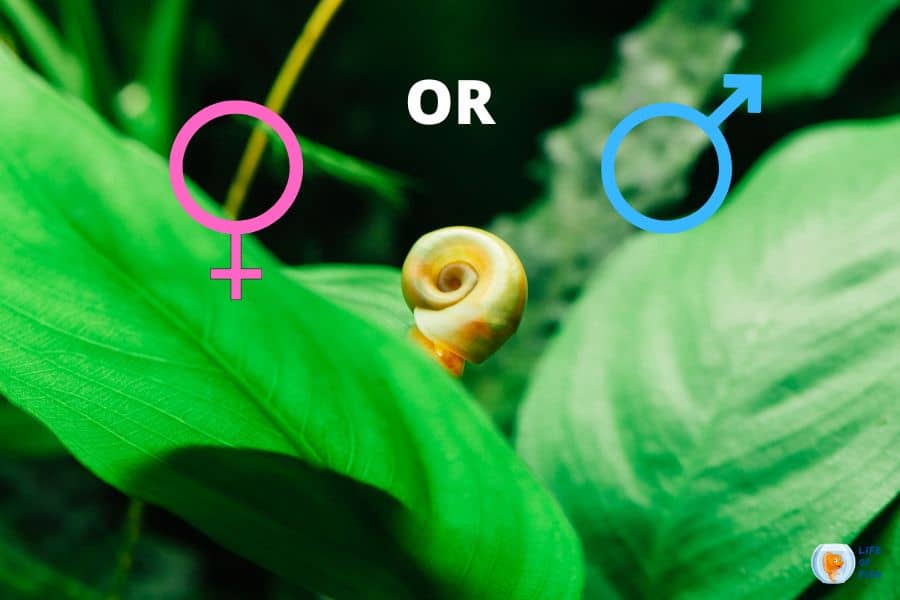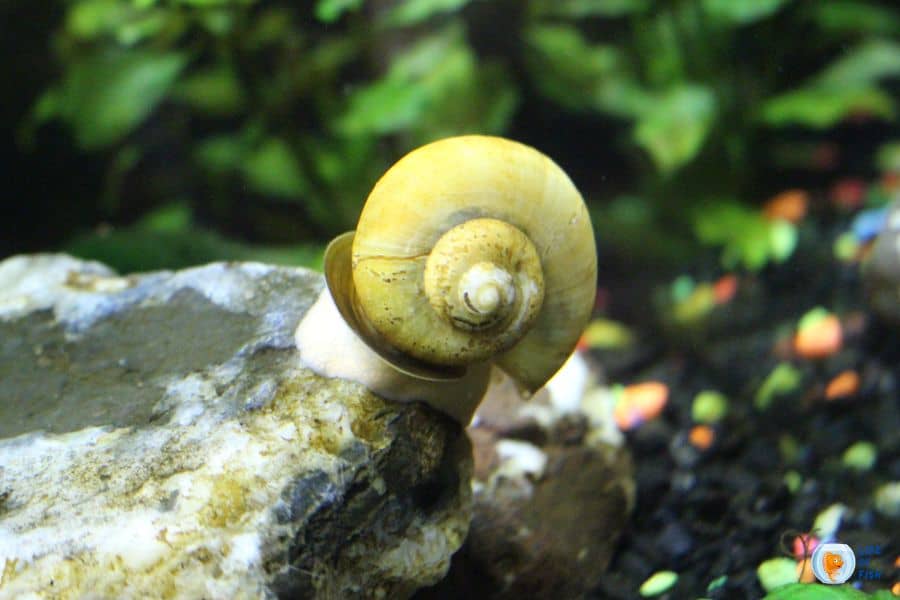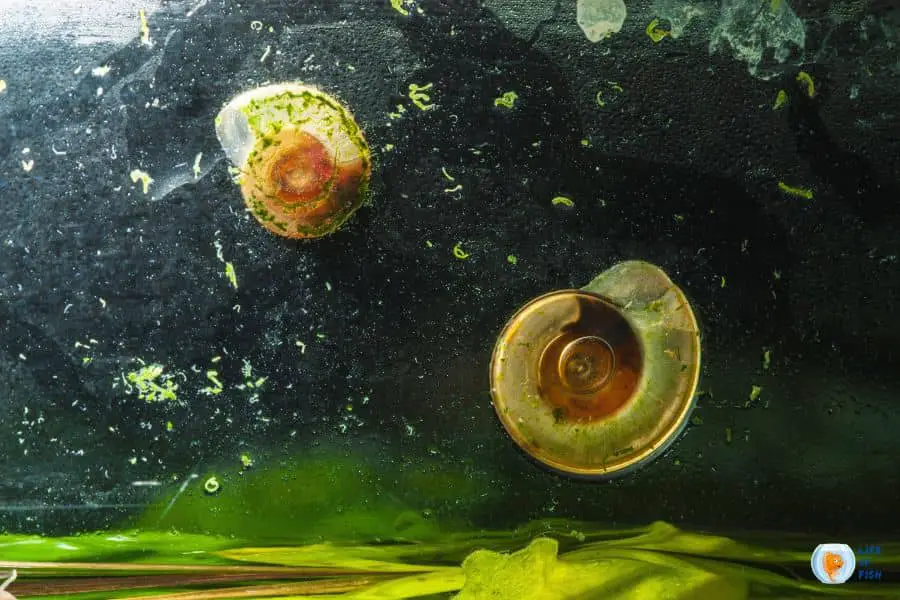Snails are a popular choice for pets and even for food. Many people are unaware of how to tell the gender of a snail. If you are trying to buy a snail as a pet and want to know if it’s a boy or girl, keep reading.
The majority of snail species are hermaphrodites, which means that they have both male and female reproductive organs. Therefore they are able to produce both sperm and eggs. Nevertheless, there are some snail species that are not hermaphrodites such as Mystery snails. You can determine the gender of those snail species by looking at a few aspects such as their physical characteristics, their behavior, and the color of their shell.

How to tell the gender of a snail?
Jump To
If your snail is gonochoric you can identify its gender by careful observing. Take out the snail from the aquarium and keep the snail on its back, belly facing the sky, for one to 10 minutes. Watch for the snail’s foot, a wide, flat membrane, which it will extend in order to try and right itself. You can have a magnifying glass to see clearly.
As its foot extends, examine the right mantle cavity, attached to the inside of the shell over the head and neck. Then you can see the snail’s relatively large penis sheath. If you don’t see one, the snail is female. However, gonochoric snails can change their sex too. Therefore, you may find a snail once you recognize that a female is a male in another time!
How many genders do snails have?
Determining the gender of a snail is actually a complex thing. There are some snail species that have female and male snails. They also can change their gender according to the environment. The majority of snails have both male and female organs in one snail. They can have babies with or without mating depending on the species. In conclusion, snails can be female, male, or hermaphrodite depending on the species.
Do male snails lay eggs?
As described earlier, most snails are hermaphrodites and have both reproductive organs in their bodies. When two hermaphrodite snails meet, they will vie for position on who is going to be the male or female. Generally, the deciding factor is which snail gets the better placement of the love dart. However, the males of gonochoric snail species cannot lay eggs if they would not become females later on.

Related questions
How to tell if a snail is pregnant
Snails are unique creatures, regarding their gender as well as their reproduction. Their signs of pregnancy vary depending on the species. Some snails are egg layers and some are livebearers. You can figure out if your snail is about to have babies by examining her and observing her behavior if you know which species your snail belongs to.
Egg bearing species
If you have egg-bearing species, you can tell your snail is pregnant by looking in her genital tube. Hold her by the shell with her body facing you and wait for her to come out of her shell. Her genital tube is located on the left side of her body if she’s facing you. The eggs will look like tiny, sticky, transparent orbs.
Live Bearing Snail
If your snail belongs to a live-bearing species such as the Japanese trapdoor snail, the babies will be visible in the mother snail’s shell. They have eggs in her shell and will hatch in it. The first stage of babies will be spent in the mother’s shell. Many livebearing species bury themselves in the substrate until their babies are ready to emerge from the mother’s shell. If your snail has buried herself in the gravel, she’s likely to be pregnant.
How to tell if a mystery snail is male or female
As described above Mystery snails are not hermaphrodites and there are male and female individuals. The easiest way to check the snail’s gender is by turning it upside down. This way, you’ll be able to recognize if it’s a female or a male snail. You have to examine the upper part of the right mantle cavity. If your snail is male you can see the penis sheath next to the gills. If you don’t see a penis sheath, it’s female.
There is another interesting way to identify the gender of a snail. It is their shell! If the shell of the Mystery snail becomes translucent it means the particular snail has entered its breeding time. Now you can be sure that it’s a female snail. You can wait until their breeding time and select the female snail. However, you have to wait until your snail becomes mature to identify its gender for the methods described above.
Determining the gender of a snail by observing the behavior is another interesting way. However, this way can help only if you have more of them. If you notice a snail climbing onto another one, it’s a male. Mystery snails are not asexual and it is the way that males impregnate the female. Not like many other snail species, the reproductive system of the Mystery snail requires both a male and a female snail to have eggs. It is not a short time process. Once the male snail inserts its penis into the female genital aperture, it will remain this way for several hours.
The male will hide in its shell and wait for the fertilization to be completed throughout the hours. The female snail will go on with her daily activities. After completing the fertilization, the female will come above water and lay eggs. Usually, they lay eggs at night. You can determine the gender of snails in that way too.
There is another way to determine the gender of a snail though it is not a scientifically proven method. It is to check the color of the shell. Usually, males have brighter shells than females. Many aquarists affirm that it’s accurate. Although you find their gender, they may change it due course! Yes, Mystery snails can change their sex.
This happens due to various circumstances. The environment is the main cause that they change their sex. They change their sex if they don’t feel comfortable. The other factors are their size and the water quality they live in. Even if a mystery snail changes its sex, it will still require a male or female counterpart for breeding.

How many babies do snails have?
Talking about freshwater snails, they lay hundreds of eggs at a time. The number of babies depends on how many eggs are fertilized and healthy. Though they lay hundreds of eggs, usually, between 20 and 50 babies hatch successfully. Their babies immediately move into survival mode after hatching. They often eat their own eggs for the calcium they require to harden their shells.
Can snails lay eggs without mating?
As the majority of the snails are hermaphrodites, you may think they can have babies without mating. But all hermaphrodite snails cannot do this. The majority of the hermaphrodite species need a partner to lay eggs. Others can lay eggs without mating.
Conclusion on how to tell the gender of a snail
The gender and mating behavior of snails is one of the most complex things to explain. Snails can be hermaphrodite or gonochoric depending on the species to which they belong. Even the gonochoric snails can change their gender later based on various factors. The majority of hermaphrodite snail species need to mate to have babies while the others do not need to mate.
The species that do not need a partner to have babies self-fertilize, as they have both eggs and sperm inside. You can identify male and female snails by carefully observing their physical appearance, behavior, and the color of the shell. They lay hundreds of eggs and approximately 50 % of them can be babies! Therefore, closely monitor your aquarium if you don’t need to have many snails as these creatures can mate approximately five times per year.
Read Next : Fish Constipation – Causes, Treatment, And How To Prevent
